Ultimate Guide to the Care of Cyclamens in Australia: Tips for Thriving Plants
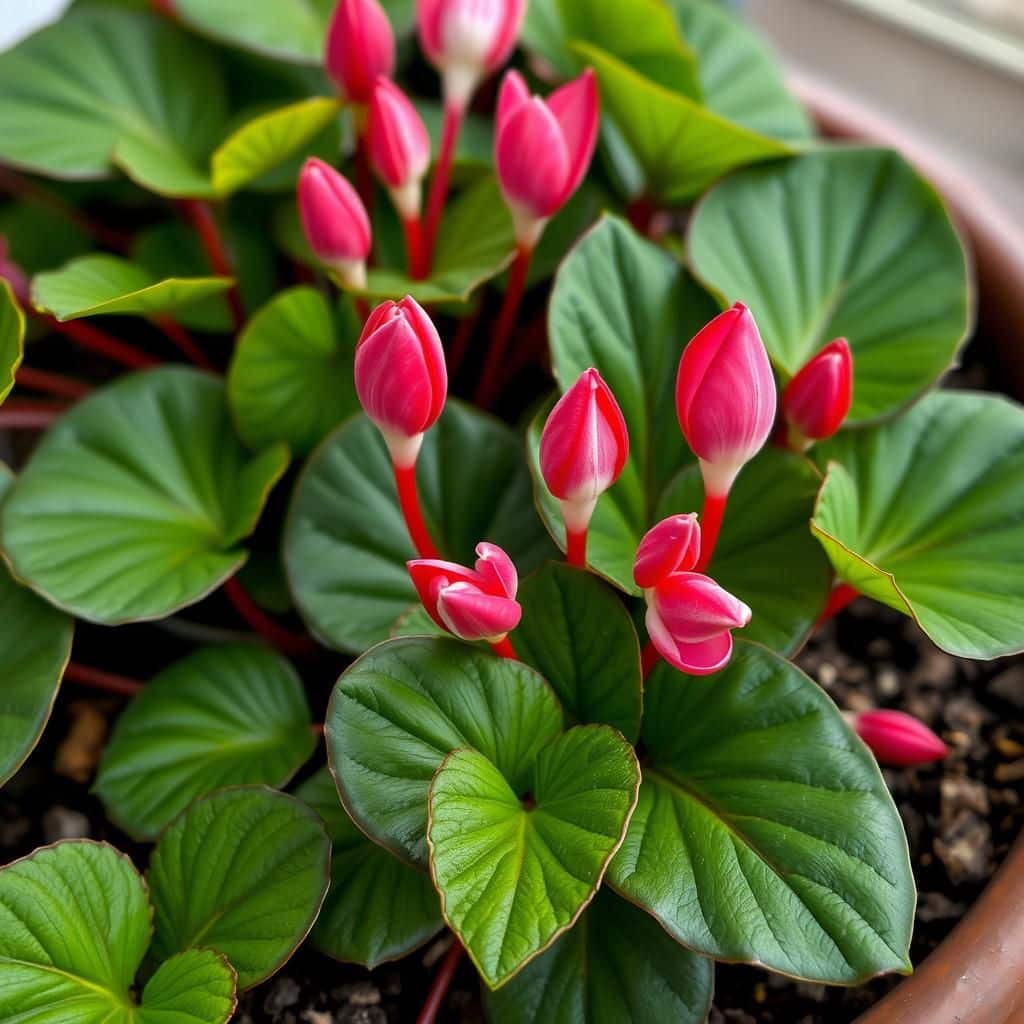
Cyclamens are a stunning choice for both indoor and outdoor gardens in Australia, known for their vibrant flowers and lush foliage. However, they require specific care to thrive in the varying Australian climates. This ultimate guide delves into essential tips for nurturing cyclamens, ensuring they flourish throughout the year. From understanding their ideal growing conditions to common pests and diseases, we will equip you with the knowledge needed to maintain these beautiful plants. Whether you are a seasoned gardener or a novice, our comprehensive advice will help you create a thriving cyclamen garden that brings joy to any space.
Proper Care of Cyclamens in Australia
Caring for cyclamens in Australia requires attention to their unique growing conditions, particularly due to the country's diverse climate. These plants thrive best in cool, temperate regions with temperatures ranging between 10°C and 20°C. In addition, it is crucial to provide them with bright, indirect light and well-draining soil to prevent root rot. Cyclamens need consistent moisture, but avoid overwatering to ensure the tubers remain healthy. During the hotter months, it may be necessary to keep them in a more sheltered environment to maintain adequate humidity and coolness. Proper care will help these beautiful flowering plants flourish, providing blooms from winter through early spring.
Light Requirements for Cyclamens
Cyclamens prefer bright, indirect light to thrive. Direct sunlight can scorch their leaves and reduce flowering, so it’s essential to place them in a location that filters light effectively. A north or east-facing window works well, as these spaces receive adequate brightness without the harshness of direct sun. In regions with intense sunlight, consider using sheer curtains to soften the light while still allowing your cyclamens to photosynthesize properly.
Watering Techniques
To keep cyclamens healthy, a careful watering regimen is vital. It is recommended to use room-temperature water and to water the plants when the top inch of soil feels dry to touch. Overwatering can lead to bulb rot, while underwatering can cause wilting and stress. It's important to water directly into the soil and avoid wetting the leaves, as this can encourage fungal diseases.
Soil and Fertilization
The choice of soil is critical for the health of cyclamens. A well-draining potting mix that consists of equal parts potting soil, perlite, and coarse sand creates an ideal environment. Fertilizing should be done every four to six weeks during the growing season with a balanced liquid fertilizer, diluted to half strength, to promote vigorous growth and abundant blooms.
Temperature and Humidity Levels
Cyclamens thrive in cooler environments, with ideal temperatures ranging from 10°C to 20°C. Maintaining humidity around the plants can be achieved by misting them regularly or placing a tray of water with pebbles nearby. Avoid placing cyclamens in drafty areas or next to heating vents, as sudden temperature fluctuations can stress the plants.
Pest and Disease Management
Monitoring cyclamens for pests such as aphids or spider mites is crucial for their health. Regularly inspect the foliage and stems, and if pests are present, treat them early with insecticidal soap or neem oil. Additionally, taking care to ensure proper air circulation around the plants and avoiding excess moisture can help prevent diseases such as botrytis blight or root rot, allowing for a healthier plant growth.
| Aspect | Best Practice |
|---|---|
| Light | Bright, indirect light |
| Watering | When the top inch is dry |
| Soil | Well-draining potting mix |
| Temperature | 10°C to 20°C |
| Pests | Check regularly, use insecticidal soap |
What do you do with cyclamen when they have finished flowering?
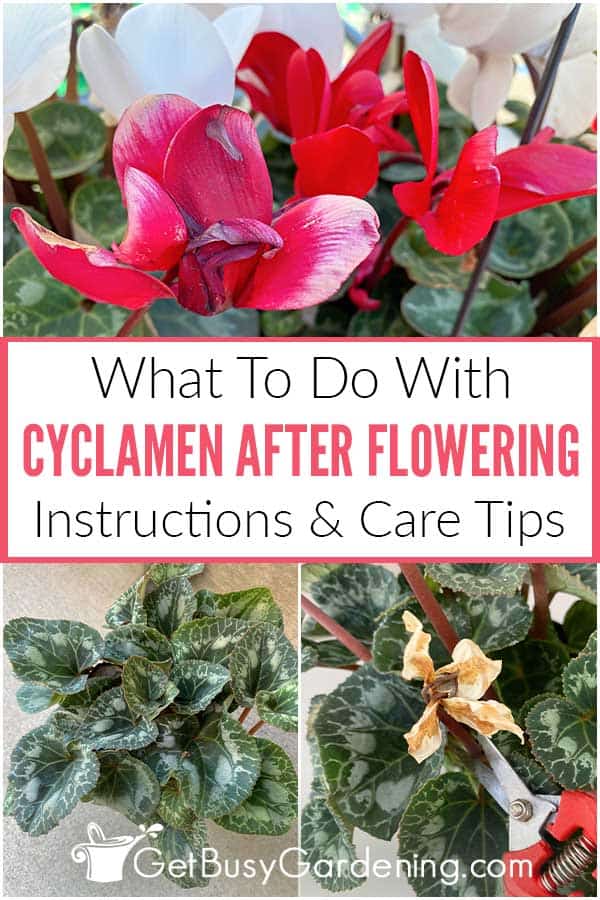
When cyclamen have finished flowering, it is important to care for them properly to ensure they remain healthy and can bloom again in the next season. Here are the steps to follow:
1. Allow the Leaves to Die Back: After flowering, it is crucial not to cut the leaves immediately. The leaves are responsible for photosynthesis, which helps the plant store energy for the next blooming period. Allow the foliage to turn yellow and die back naturally.
2. Reduce Watering: As the plant enters its dormant phase, gradually decrease the frequency of watering. Ensure that the soil dries out between waterings, as over-watering can lead to bulb rot.
3. Store the Bulb: Once the leaves have completely died back, you can remove the plant from its pot and store the bulb in a cool, dry place. This dormant period can last several months.
4. Repotting: Before the next growing season starts, it is a good idea to repot the bulb into fresh soil. Choose a well-draining potting mix suitable for bulbous plants to promote healthy root development.
5. Reintroduce Water: As the growing season approaches, begin to water the bulb again. This will encourage new growth and help prepare the plant for the next flowering period.
See also: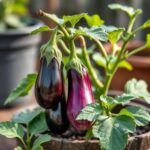
Preparing Cyclamen for Dormancy
Before cyclamen enter the dormancy stage, it is essential to prepare them correctly.
- Stop fertilizing: A few weeks after flowering, stop feeding the plant.
- Allow natural die-back: Do not force the leaves to die early; let them yellow naturally.
- Monitor temperature: Keep the plant in a cooler location while it prepares for dormancy.
Caring for Cyclamen Bulbs
After allowing the leaves to die back, care for the bulbs is essential for their next growth cycle.
- Remove from soil: Carefully lift the bulb from the pot without damaging it.
- Dry properly: Allow the bulb to dry completely in a shaded area.
- Store in a cool place: Store bulbs in a paper bag or a ventilated box in a cool location.
Repotting Cyclamen
When it’s time to repot cyclamen, follow these steps to ensure successful growth.
- Choose a new pot: Make sure the pot has good drainage holes to prevent excess moisture.
- Use fresh potting mix: A quality, well-draining potting mix is ideal for cyclamen.
- Plant properly: Place the bulb so that the top half is exposed above the soil level.
Watering After Dormancy
Proper watering techniques are crucial as cyclamen emerge from dormancy.
- Start slowly: Initiate watering gradually, allowing the soil to dry slightly between waters.
- Use room temperature water: This helps prevent shock to the bulb as it reawakens.
- Watch for signs of growth: Begin watering more regularly once you see new leaves.
Encouraging Reblooming of Cyclamen
To encourage cyclamen to bloom once more, certain conditions must be met.
- Provide adequate light: Ensure they receive indirect bright light to stimulate growth.
- Maintain temperature: Keep the plant in a cool area, as cyclamen thrive in cooler conditions.
- Resume fertilizing: After new growth appears, begin fertilizing with a low-nitrogen fertilizer.
Why are the leaves on my cyclamen turning yellow in Australia?
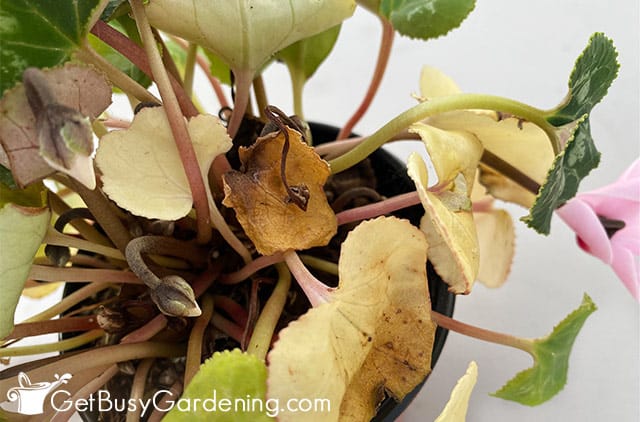
The yellowing of leaves on your cyclamen can be attributed to a variety of environmental and care-related factors. In Australia, where climates can vary significantly, it is crucial to identify specific causes to address the issue effectively.
Overwatering Issues
One of the most common reasons for yellow leaves in cyclamen is overwatering. Cyclamen plants are tuberous perennials that do not like to sit in water. When the roots become waterlogged, they can develop root rot, leading to yellowing foliage.
- Check the watering frequency: Ensure you water the plant only when the top layer of soil feels dry.
- Ensure proper drainage: Use pots with adequate drainage holes to help prevent water accumulation.
- Avoid watering the leaves: Direct water on the leaves can promote fungal diseases and damage.
Insufficient Light Conditions
Cyclamen thrive in bright, indirect light, and insufficient lighting can lead to yellowing leaves. If your plant is located in a dim or overly shaded area, it may not receive the light it needs to grow properly.
- Evaluate light conditions: Place your cyclamen near a window with filtered light.
- Avoid direct sunlight: Prolonged exposure to intense sunlight can scorch the leaves, so indirect light is preferable.
- Rotate the plant: Regularly rotating your plant can help provide even light distribution, promoting balanced growth.
Nutrient Deficiencies
A lack of essential nutrients can also cause yellowing leaves in cyclamen. Key nutrients like nitrogen, potassium, and magnesium are vital for healthy foliage and overall plant vitality.
- Use a balanced fertilizer: Choose a water-soluble fertilizer and follow the recommended dilution rates to avoid over-fertilization.
- Fertilize during the growing season: Apply nutrients every 4-6 weeks during the active growth period.
- Observe plant response: Monitor the plant after fertilization; if you still see yellowing, you may need to adjust your fertilization strategy.
Temperature and Humidity Factors
Temperature extremes and low humidity can adversely affect cyclamen health. Cyclamen prefer cooler temperatures and may develop yellow leaves if exposed to heat stress or dry conditions.
- Maintain optimal temperatures: Keep your cyclamen in an environment between 15-20°C (59-68°F) for best growth.
- Increase humidity: Consider using a humidity tray or misting the plant occasionally to raise humidity levels.
- Avoid cold drafts: Protect your cyclamen from sudden temperature changes or drafts, which can lead to stress.
Pest Infestation
Pests such as aphids, spider mites, and mealybugs can ravage cyclamen plants, often resulting in yellowing leaves as the plant becomes weak and nutrient-deficient.
- Inspect the leaves: Check for any signs of insects or webbing on the plant.
- Use appropriate pest control: Employ insecticidal soap or neem oil for treatment if you identify any pests.
- Regularly monitor your plant: Keep an eye on your cyclamen to catch any pest issues early before they escalate.
How long do potted cyclamen last?
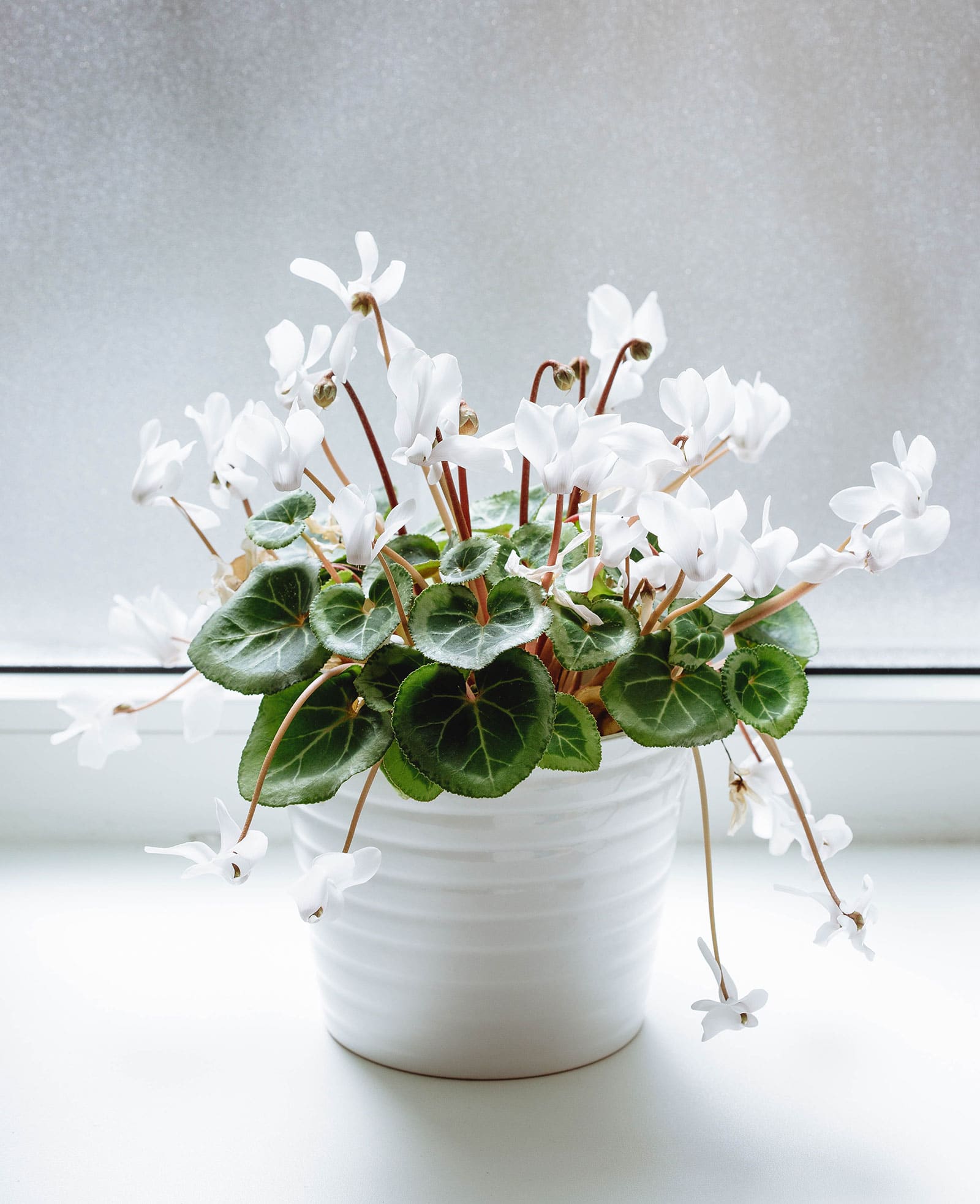
Potted cyclamen can last anywhere from three to six months when properly cared for. Their lifespan can be influenced by various factors, such as environmental conditions, care routines, and the specific variety of cyclamen. During their growth period, they typically bloom in the cooler months of the year, providing a beautiful display of flowers. Upon completion of their blooming cycle, the foliage may start to decline, and the plant may enter dormancy.
See also:
Understanding Cyclamen Lifespan
Cyclamen have a unique lifecycle that includes a dormant phase. This phase usually occurs during the warmer months, where the plant's leaves may die back, and it appears to be inactive. During dormancy, the plant can last for several months without water, allowing it to conserve energy. After the dormant period, with the right conditions, it will resume growth and potentially flower again.
- Types of Cyclamen: Different species and varieties have varying lifespans and blooming habits.
- Indoor vs. Outdoor: Cyclamen grown indoors typically have different longevity compared to those grown outdoors.
- Temperature: Cyclamen thrive in cooler temperatures, influencing their overall health and lifespan.
Factors Influencing Longevity
Several factors play a crucial role in determining how long potted cyclamen can live. Environment, care, and pest management significantly affect their health and blooming duration. Ensuring they receive the right amount of light, appropriate watering schedules, and avoiding extreme temperatures can help extend their life.
- Watering Practices: Overwatering can lead to root rot, while underwatering can lead to wilting.
- Light Conditions: Too much direct sunlight can scorch the leaves, whereas too little light can hinder blooming.
- Fertilization: Using the right type and amount of fertilizer can promote healthier plants and longer lifespans.
Signs of Decline
As cyclamen ages, you may observe specific signs that indicate they are reaching the end of their blooming period. The leaves may start to yellow, and flowers may become less vibrant. Recognizing these signs early can allow you to adjust care methods and possibly prolong their life.
- Yellowing Leaves: This is often the first sign that the plant is approaching dormancy.
- Loss of Flowers: A decrease in blooming frequency indicates that the plant may need a rest period.
- Decreased Leaf Growth: Slower growth can signal the plant is not in its optimal condition.
Care Tips for Longevity
To maximize the lifespan of potted cyclamen, adhering to specific care techniques is essential. Proper watering, light, and temperature control will significantly impact their overall health and flowering duration. A little attention goes a long way in ensuring that cyclamen thrive for as long as possible.
- Water Appropriately: Water when the soil feels dry to the touch, avoiding sogginess.
- Provide Indirect Light: Choose a location with bright, filtered sunlight for optimal growth.
- Monitor Temperature: Keep them in a cool area, ideally between 50°F and 70°F (10°C - 21°C).
Post-Bloom Care
After the blooming period, potted cyclamen need specific care to ensure they can enter dormancy and return for another blooming season. Post-bloom care involves adjusting watering and light levels to help the plant rest and recuperate.
- Reduce Watering: Gradually decrease watering to allow the plant to rest.
- Remove Dead Leaves: Trim away any dead or yellowing foliage to prevent disease.
- Store in a Cool Place: Keeping cyclamen in a cooler environment during dormancy will support their recovery.
Do cyclamens like full sun?
:max_bytes(150000):strip_icc()/KaraRiley-11-a775c1c562804fae80a0be9c4a4dd40b.jpg)
Cyclamens are beautiful flowering plants that thrive in specific conditions. When it comes to the question of whether cyclamens like full sun, the answer is generally no. Cyclamens prefer indirect sunlight or partial shade rather than direct sunlight. Too much exposure to full sun can lead to wilting and may damage their delicate leaves and flowers.
Cyclamen Sunlight Requirements
Cyclamens require moderate exposure to light for optimal growth. They naturally grow under the canopies of trees in their native habitats, which means they are adapted to lower light conditions. In cultivation, it is recommended to provide them with bright, filtered light.
- Ideal light levels are around 50-75% shade.
- Direct sunlight can scorch leaves.
- Look for areas with morning sun and afternoon shade.
Effects of Full Sun on Cyclamens
When cyclamens are exposed to full sun, they can experience several adverse effects. The intense heat can cause the soil to dry out too quickly, leading to stress on the plant.
- Leaves may curl or turn yellow.
- Flowers may wilt prematurely.
- The overall vigor of the plant may decline.
Best Locations for Planting Cyclamens
Choosing the right location for planting cyclamens is crucial. They thrive in settings where there is dappled sunlight or filtered light instead of harsh, direct sun.
- Under trees or shrubs provides natural shade.
- Close to a north-facing wall or building may keep them cooler.
- Indoor settings with indirect sunlight work well.
Watering Considerations for Cyclamens in Sunlight
The watering needs of cyclamens change depending on their light exposure. If they do receive more sunlight, it is crucial to monitor their moisture levels carefully.
- Keep the soil moist but not soggy.
- Water less frequently in hotter, sunnier conditions.
- Provide consistent moisture during the growing season.
Seasonal Care for Cyclamens
Understanding the seasonal needs of cyclamens can help in providing the best care, especially when considering light conditions.
- In winter, they bloom and require more light.
- During the summer dormancy, reduce watering significantly.
- After blooming, continue to provide indirect light for leaf growth.
Questions from Our Readers
How often should I water cyclamens in Australia?
Cyclamens prefer moderate watering, so it’s essential to ensure the soil remains moist but not soggy. In general, watering every 1 to 2 weeks is sufficient, but it's important to check the top layer of the soil for moisture before adding more water.
What type of soil is best for cyclamens in Australia?
Cyclamens thrive in a well-draining soil mix rich in organic matter. A suitable mixture often includes peat, perlite, and potting soil to ensure good drainage while retaining adequate moisture for the plants.
See also:
What temperature is ideal for cyclamens in Australia?
Cyclamens prefer cooler temperatures, typically between 15°C and 20°C (59°F and 68°F). It's critical to avoid exposing them to temperatures above 22°C (72°F), as this can cause the plants to become stressed and decline.
When is the best time to fertilize cyclamens?
The best time to fertilize cyclamens is during their active growing season, usually in spring and early summer. Using a balanced, water-soluble fertilizer every few weeks can promote healthy growth and flowering.

If you want to read more articles like Ultimate Guide to the Care of Cyclamens in Australia: Tips for Thriving Plants, we recommend you check out our Pots category.
Leave a Reply
Related Articles